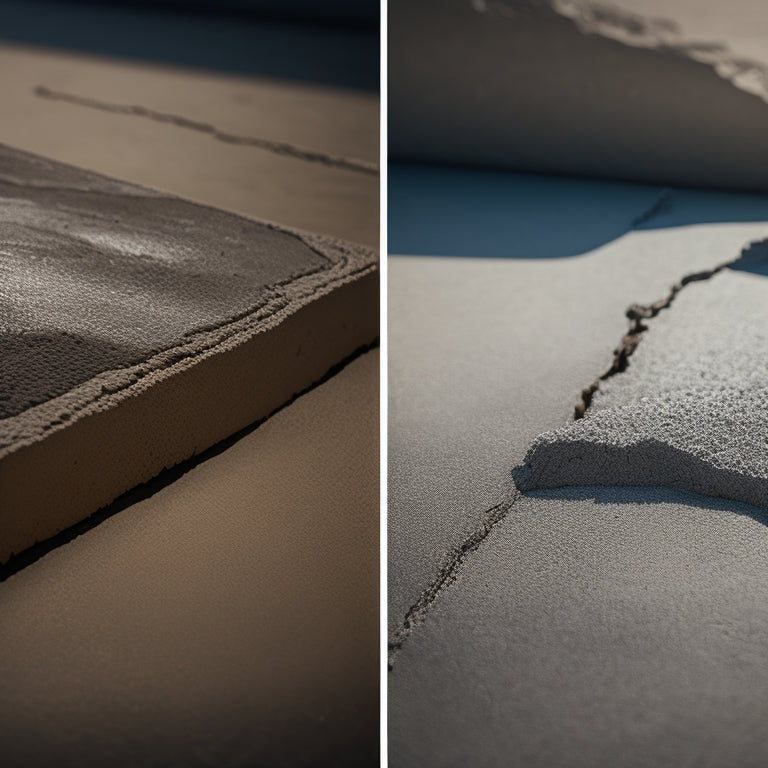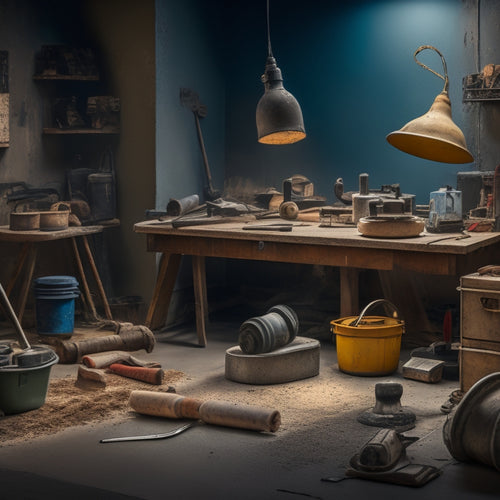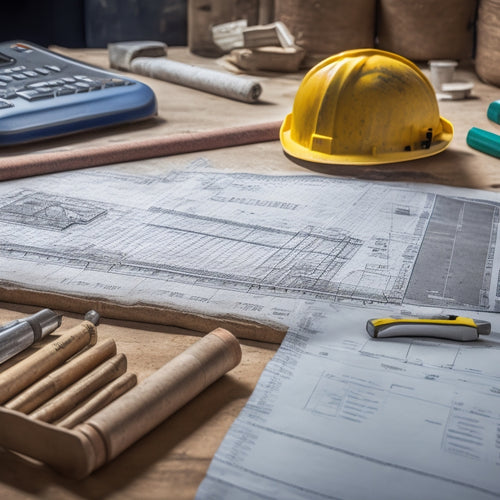
What Tools Ensure Strong Concrete Adhesion at Home
Share
You'll need the right tools to guarantee strong concrete adhesion at home. For surface preparation, use concrete surface preparation tools, sealant removal scraping tools, and wire brush cleaning accessories. To apply adhesives, bond with bonding agent applicator guns, epoxy resin mixing paddles, and primer application roller extensions. Don't forget high-pressure wash nozzles for cleaning and moisture barrier installation kits for a watertight seal. Finishing tools like power trowels and polymer modified cement mixers will help you achieve a professional finish. With these tools, you'll be well on your way to achieving strong concrete adhesion - and there's more to explore to guarantee a successful project.
Key Takeaways
- Proper surface preparation is critical for adhesion, and tools like pressure washers, acid etching, and mechanical scrubbing help achieve this.
- Removing old paint and sealants using chemical stripping, mechanical stripping, and scraping tools ensures a strong bond with the adhesive.
- Bonding agent applicator guns, epoxy resin mixing paddles, and primer application roller extensions are essential for efficient and effective adhesive application.
- High-pressure wash nozzles, moisture barrier installation kits, and barrier film application tools help create a strong bond between concrete and adhesives.
- Finishing tools like power trowels and polymer modified cement mixers enhance adhesion properties and ensure a strong, long-lasting bond.
Bonding Agent Applicator Guns
Applying bonding agents efficiently and effectively is essential for achieving strong concrete adhesion, and utilizing a bonding agent applicator gun can greatly streamline this process.
You can choose from various bonding agent types, such as epoxy-based, acrylic-based, or polyurethane-based agents, each suited for specific applications and environmental conditions. When selecting a bonding agent, consider factors like surface porosity, substrate type, and exposure to chemicals or weathering.
To guarantee peak performance, maintain your applicator gun regularly. Clean the gun's nozzle and barrel after each use to prevent clogging, and store it in a dry, protected area.
Regularly inspect the gun's seals and O-rings for signs of wear, replacing them as needed to prevent leaks. Proper maintenance will extend the life of your applicator gun and guarantee consistent, precise application of bonding agents.
Concrete Surface Preparation Tools
You'll need to guarantee the concrete surface is properly prepared before applying a bonding agent, and that starts with cleaning the surface to remove dirt, oil, and other contaminants that can weaken adhesion.
You'll also need to remove old paint or coatings that may be flaking off, as these can create a weak bond between the old surface and the new material.
Clean the Surface
Preparing a concrete surface for adhesion requires meticulous attention to detail, and cleaning the surface is a critical first step.
You'll need to remove surface contaminants, such as dirt, grime, and oils, which can compromise the bond between the concrete and the adhesive. Start by sweeping or blowing away any loose debris, then use a pressure washer to remove stubborn dirt and grime.
For more thorough cleaning, employ specialized cleaning techniques, such as acid etching or mechanical scrubbing, to remove tough surface contaminants.
When selecting a cleaning method, consider the type of surface contaminants present and the surface's porosity.
Acid etching, for instance, is effective for removing dirt and grime from smooth surfaces, while mechanical scrubbing is better suited for textured or porous surfaces.
Always follow the manufacturer's instructions for cleaning products and tools to verify the surface is properly prepared for adhesion.
Remove Old Paint
Most existing concrete surfaces have a layer of old paint that must be removed to secure a strong bond between the concrete and the new adhesive.
You'll need to employ effective paint stripping techniques to guarantee a thorough removal. Chemical stripping is a popular method, involving the application of a solvent-based stripper to break down the paint. You can then scrape off the old paint using a putty knife or wire brush.
Alternatively, you can use a mechanical stripping method, such as sanding or grinding, to remove the paint. Regardless of the technique you choose, make sure to wear protective gear, including gloves, safety glasses, and a mask.
Once you've removed the old paint, you'll need to dispose of it properly. Check with your local authorities for guidance on old paint disposal, as regulations may vary. You may need to take the paint to a designated hazardous waste collection facility.
After removal and disposal, your concrete surface is ready for further preparation, including cleaning and profiling, to guarantee a strong bond with the new adhesive.
Epoxy Resin Mixing Paddles
A mixing paddle's design plays an essential role in achieving a thorough blend of epoxy resin components, as an improper mix can lead to subpar adhesion and compromised structural integrity.
When working with epoxy resin applications, you need a paddle that can effectively combine the resin and hardener, guaranteeing a strong bond between the concrete and the epoxy.
Epoxy resin mixing paddles are designed specifically for this purpose. They typically feature a spiral or helical design, which helps to scrape the sides and bottom of the mixing container, eliminating any unmixed material.
This design also aids in breaking down any air bubbles that may form during the mixing process.
Some epoxy resin mixing paddles also offer epoxy color options, allowing you to mix and match different colors for your specific project.
This feature is particularly useful when you need to achieve a specific aesthetic or match an existing color scheme.
High-Pressure Wash Nozzles
You've mixed and applied your epoxy resin, guaranteeing a strong bond between the concrete and the epoxy. Now, it's time to focus on preparing the surface for ideal adhesion.
High-pressure wash nozzles are essential tools for this step. These nozzles are designed for high-pressure applications, allowing you to effectively clean and prepare the concrete surface.
When choosing a high-pressure wash nozzle, take into account the type of nozzle you need. Fan nozzles are ideal for wide areas, while pinpoint nozzles are better suited for small, hard-to-reach spaces. You may also want to think about nozzles with adjustable spray patterns to give you more control over the cleaning process.
Using a high-pressure wash nozzle, you can remove dirt, grime, and other contaminants that can compromise the bond between the epoxy and concrete. This guarantees a strong, long-lasting adhesion that can withstand various environmental conditions.
Moisture Barrier Installation Kit
When installing a moisture barrier, you'll need to apply the barrier film correctly to guarantee a strong bond between the concrete and the membrane. This involves selecting the right type of film and applying it smoothly, without wrinkles or air pockets.
Next, you'll need to master membrane sealing techniques, such as applying the correct amount of pressure and using the right adhesives to create a watertight seal.
Barrier Film Application
Secure the substrate by applying the moisture barrier film, a critical step in guaranteeing strong concrete adhesion. When applying the film, you'll need to verify it's free from wrinkles, air pockets, and tears. Use a vacuum pump or a broom to remove any air bubbles, and apply pressure to secure the film to the substrate.
Make sure to follow the manufacturer's instructions for the recommended film thickness, as this can affect adhesion testing results. A minimum thickness of 10 mils is typically recommended for most applications.
During application, maintain a clean and dry environment to prevent contamination. Ascertain the substrate is level, smooth, and free from any debris or oils that could compromise adhesion.
Apply the film in sections, overlapping each section by at least 6 inches to prevent water infiltration. Use a roller or trowel to apply even pressure, guaranteeing the film is securely attached to the substrate.
Membrane Sealing Techniques
With the moisture barrier film in place, attention turns to sealing the membrane. You'll focus on guaranteeing a watertight seal to prevent water infiltration and compromised adhesion.
There are various membrane types, including self-adhering and torch-applied options, each requiring specific adhesion techniques.
For self-adhering membranes, you'll apply pressure to guarantee a strong bond between the membrane and the substrate. Use a roller or squeegee to remove air pockets and excess water, promoting a secure seal.
Torch-applied membranes, on the other hand, require heat to activate the adhesive. Apply the membrane to the substrate, then use a torch to melt the adhesive, guaranteeing a strong bond.
When sealing the membrane, pay attention to critical areas, such as corners, edges, and penetrations. Use specialized sealants and adhesives designed for moisture barrier applications to guarantee a watertight seal.
Polymer Modified Cement Mixers
By incorporating polymer modifiers into cement mixers, you can markedly enhance the adhesion properties of concrete. These additives introduce unique polymer properties that improve the bonding between the cement paste and aggregate particles. As a result, you can achieve a more uniform and robust concrete structure.
When using polymer modified cement mixers, it's vital to follow ideal mixing techniques to guarantee the additives are evenly distributed. Start by adding the polymer modifier to the mixing water before combining it with the cement and aggregate. This allows the polymer to fully hydrate and interact with the cement particles.
Next, mix the components for an extended period to break down the polymer chains and facilitate their bonding with the cement. Proper mixing techniques are fundamental to access the full potential of polymer modified cement mixers and achieve strong concrete adhesion.
Power Trowels for Finishing
Finishing concrete surfaces requires precision and control, which is where power trowels come into play. You'll need a reliable power trowel to achieve a smooth, even finish. There are several power trowel types to choose from, each suited for specific tasks.
| Power Trowel Type | Suitable For | Maintenance Requirements |
|---|---|---|
| Walk-behind trowels | Large areas, high-traffic zones | Regularly clean and lubricate bearings, check and replace worn-out blades |
| Ride-on trowels | Massive concrete slabs, industrial projects | Perform daily checks on hydraulic fluid levels, inspect and replace worn-out parts |
| Edger trowels | Edging, detail work, and small areas | Clean and store properly after use, regularly inspect and replace worn-out blades |
When selecting a power trowel, consider the size of your project, the type of concrete, and the level of finish required. Regular trowel maintenance is essential to guarantee peak performance and extend the tool's lifespan. By choosing the right power trowel and following proper maintenance procedures, you'll achieve a professional-grade finish that will last.
Primer Application Roller Extensions
A well-prepared surface is essential for strong concrete adhesion, and primer application plays an important role in achieving this. When applying primer, you'll want to use the right tools to guarantee an even, consistent coat. This is where primer application roller extensions come in.
These tools allow you to reach larger areas and apply primer with precision and control. You'll find various roller types designed for specific application techniques. For example, microfiber rollers are ideal for smooth surfaces, while nap rollers are better suited for textured or rough surfaces.
Extension poles with adjustable handles enable you to customize the length and angle of your roller, making it easier to reach corners, edges, and curved areas.
Sealant Removal Scraping Tools
Most sealant removal projects involve scraping off old, degraded sealants from concrete surfaces. You'll need the right tools to effectively remove old sealants without damaging the concrete.
Sealant removal scraping tools are designed to tackle specific sealant types, so it's crucial to choose the correct tool for your project. For instance, if you're dealing with a silicone-based sealant, you'll need a scraper with a flexible, rubberized edge to prevent scratching the concrete. On the other hand, epoxy-based sealants require a more aggressive scraper with a metal edge to break down the strong adhesive properties.
When selecting a sealant removal scraping tool, consider the type of sealant you're working with and the condition of the concrete surface. A putty knife or scraper with a curved edge is ideal for removing old sealants from uneven surfaces, while a flat-edged scraper is better suited for smooth surfaces.
Remember to always scrape in the direction of the concrete's aggregate to avoid scratching the surface. With the right sealant removal scraping tool, you'll be able to effectively remove old sealants and prepare your concrete surface for new adhesives.
Wire Brush Cleaning Accessories
Three key areas of a concrete surface require special attention when preparing for new adhesives: cracks, crevices, and pores.
You'll need to guarantee these areas are thoroughly cleaned to create a strong bond between the old concrete and new adhesive. Wire brush cleaning accessories are essential for this step.
You'll find various wire brush types, each designed for specific surface cleaning techniques.
For instance:
- Stiff-bristle brushes are ideal for removing dirt and debris from large cracks and crevices.
- Soft-bristle brushes are better suited for cleaning pores and small crevices without damaging the surrounding concrete.
- Stainless steel brushes resist corrosion and are perfect for cleaning areas exposed to moisture.
- Brass brushes provide a balance between durability and flexibility, making them suitable for general-purpose cleaning.
- Electric wire brushes offer increased efficiency and speed for larger areas or more extensive cleaning projects.
Frequently Asked Questions
Can I Use a Regular Paintbrush for Applying Bonding Agents?
You shouldn't use a regular paintbrush for bonding agent applications, as it can introduce air pockets and uneven distribution. Instead, opt for a foam brush, lambswool applicator, or a notched trowel for maximum adhesion and uniform coverage.
How Often Should I Clean My Concrete Surface Preparation Tools?
You should clean your concrete surface preparation tools after every use to prevent material buildup, ensuring ideal tool maintenance and surface cleanliness for strong adhesion and a flawless finish.
Are Epoxy Resin Mixing Paddles Dishwasher Safe?
You'll find that epoxy resin mixing paddles, typically made from materials like stainless steel or silicone, aren't dishwasher safe due to epoxy resin properties, which can degrade or react with high heat and harsh detergents, compromising their effectiveness.
What Is the Ideal Pressure for High-Pressure Wash Nozzles?
When using high-pressure wash nozzles, you'll want to adjust pressure settings between 1,000-4,000 PSI, depending on nozzle types, to achieve ideal cleaning results without damaging surfaces; consult your equipment's manual for precise recommendations.
Can I Mix Polymer Modified Cement by Hand Instead of Using a Mixer?
You can attempt hand mixing polymer-modified cement, but it's essential to employ precise hand mixing techniques, as the unique properties of polymer cement require thorough blending to achieve ideal adhesion and strength.
Conclusion
With these top-tier tools, you'll tantalize tenants with terrifically tenacious concrete adhesion. Precise preparation prevents pesky problems, and proficient application guarantees a professional finish. From bonding agents to wire brush cleaning, each tool tackles a specific task, together tackling the toughest tasks. With these tools, you'll transform your terrain, turning treacherous terrain into tranquil, trustworthy surfaces.
Related Posts
-

Top Concrete Resurfacing Tools for a Pro Finish
When it comes to achieving a professional finish in concrete resurfacing projects, you require the right set of speci...
-

7 Must-Have Tools for Concrete Repair Organization
To effectively organize your concrete repair projects, you'll need a thorough toolkit that includes a well-planned st...
-

5 Tips for Accurate Concrete Measurement Tools
To guarantee accurate concrete measurement, you'll want to calibrate your measuring tools regularly, choosing a frequ...


